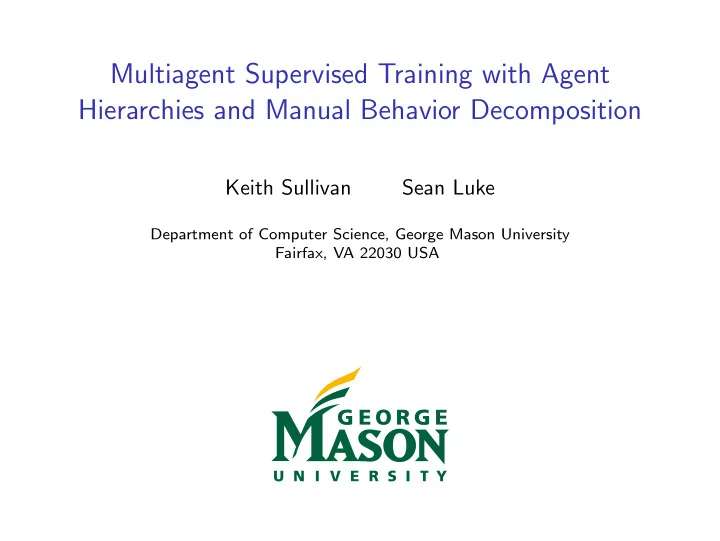

Multiagent Supervised Training with Agent Hierarchies and Manual Behavior Decomposition Keith Sullivan Sean Luke Department of Computer Science, George Mason University Fairfax, VA 22030 USA
RoboCup Motivation
Motivation for Training ◮ Programming agent behaviors is tedious ◮ Code, test, debug cycles ◮ Changing of agent behavior is desirable ◮ Non-programmers (consumers, animators, etc.) ◮ Future tasks, possibly greatly different from original task ◮ Learning from Demonstration (LfD) ◮ Iteratively builds policy from examples (state/action pairs) ◮ Supervised learning
Hierarchical Training of Agent Behaviors (HiTAB) ◮ Motivation: Rapidly train complex behaviors with very few examples ◮ Behaviors are automata ◮ Expandable behavior library ◮ Start with atomic behaviors ◮ Iteratively build more complex behaviors via scaffolding ◮ Features describe internal and world conditions ◮ Continuous, torodial, categorical (boolean) ◮ Behaviors and features are parameterizable
HiTAB (cont.) ◮ Gathering examples is expensive ◮ Each example is an experiment conducted in real-time ◮ Admission: close to programming by example and far away from machine learning ◮ Limited number of samples, but high dimensional problem! ◮ Behavior decomposition via hierarchical finite automata (HFA) ◮ Per-behavior feature reduction ◮ Learn transition functions → Supervised classification task ◮ C4.5 with probabilistic leaf nodes ◮ Different types of features
Example Behavior Acquiring: can't see forward can Start next to can grab, pick random angle can see a can Looking: Spinning: turn turn Start human present at desired angle at desired angle lost can Collect Cans Run Away human absent (Macro) (Macro) Spinning 2: Looking 2: turn turn lost can release, can see a can under bed human absent pick random angle can't see can next to can Hide Under Acquiring 2: Bed forward (a) Moore Machine (b) HFA
Formal Model ◮ S = { S 1 , ..., S n } is the set of states in the automaton. Among other states, there is one start state S 1 and zero or more flag states . ◮ B = { B 1 , ..., B k } is the set of basic (hard-coded) behaviors. ◮ F = { F 1 , ..., F m } is the set of observable features in the environment. ◮ T = F 1 × ... × F m × S → S is the transition function which maps the current state S t and the current feature vector � f t to a new state S t +1 . ◮ We generalize the model with free variables (parameters) G 1 , . . . , G n for basic behaviors and features.
Using HiTAB ◮ Running HiTAB ◮ Begin in start state ◮ Query transition function, transition, perform associated behavior ◮ Training with HiTAB ◮ Alternate training mode and testing mode ◮ Build example database, adding corrections as needed ◮ Trim unused behaviors and features for saving
Homogeneous Agent Hierarchy ◮ Problem ◮ Size of learning space grows → number of samples grows ◮ Inverse problem between micro- and macro-level behaviors ◮ Agent hierarchy: tree with coordinator agents as non-leaves and regular agents as leaves ◮ Coordinator agent features: statistical information about subsidiary agents a ◮ Agents at same level run same HFA, but might be in different states ◮ Train agents bottom-up
Notions of Homogeneity Collective Patrol Disperse Disperse Disperse Disperse Patrol Patrol Patrol Patrol Save Humanity Collective Patrol Collective Patrol Attack Attack Disperse Disperse
Experiments ◮ Simulated box Foraging ◮ Known deposit location ◮ Randomly placed boxes ◮ 10 boxes in all experiments ◮ 50 agents: two levels of hierarchy ◮ Teams of 5 agents ◮ Grouped these teams into groups of 5 ◮ Boxes require either 5 or 25 agents to pull back ◮ 100 iterations of 100,000 timesteps each
Simulation
Results 140 120 100 Mean Collected Boxes 80 60 40 20 Trained Swarm Trained Groups Hand-Coded Swarm Hand-Coded Groups 0 0 25000 50000 75000 100000 TimeStep
Preliminary Multirobot Work
Future Work ◮ Training Multiple Agents ◮ Behavior Bootstrapping ◮ Heterogeneous Groups ◮ Behavior and Capability ◮ Dynamic Hierarchies ◮ Correction of Demonstrator Error
Recommend
More recommend